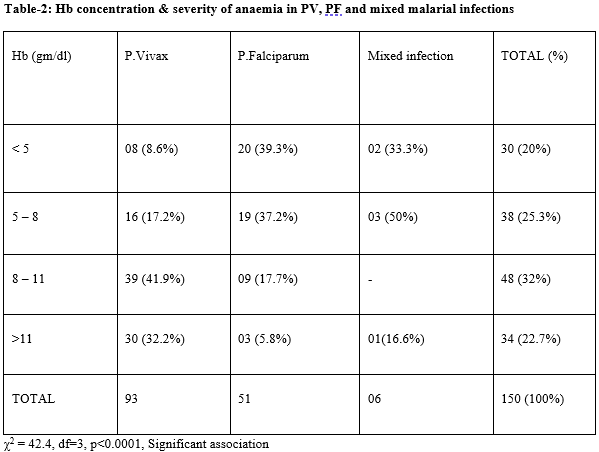Study on specific species of malaria in relation to haematological changes
Abstract
Background: As malaria is a potential medical emergency, prompt and accurate diagnosis is critical for its effective management. Conventional microscopic examination of peripheral thick and thin blood smear examination remains the “gold standard” for malaria diagnosis.
Material: A 2 year prospective study from 2011 to 2013 was conducted at Navodaya Medical College Hospital and Research Centre, Raichur. The study comprised of a total number of 150 cases positive for Malaria, collected from above mentioned centre and those referred from peripheral referral centres. Clinical history regarding age, sex, nature and duration of illness were elicited. Blood sample for haematological study was taken before starting anti-malarial drugs in all these cases.
Result: Out of total cases, P. vivax infected cases (62%) were common than P. falciparum (34%) and mixed infection cases [PV & PF] (4%). Most common presenting symptom of cases affected by PV, PF and mixed infection were fever and chills & rigors and least common symptom was cough. Most important haematological changes observed were anaemia and thrombocytopenia (77.3% each) and leucopenia (31.3%). All the above mentioned changes in haematological parameters were species specific and statistically significant, except for red cell indices, DLC and ESR.
Conclusions: In conclusion, changes in haematological profile can help in early diagnosis of specific species of malaria for timely and appropriate treatment that can reduce the severity and prevention of additional consequences.
Downloads
References
Kathryn NS, Kevin CK and Jay SK. Malaria. Canadian Medical Association Journal 2004; 170(11):1693-1702.
Layla AM, Ahmed AM, Ahmed AB and Mirghani AA. Malaria: Haematological Aspects. Annals of Saudi Medicine 2002; 22(5):372-376.
Haroon H, Fazel PA, Naeem M, Mobin A, Naqvi AH, Makki K. Hide and seek: haematological aspects of malaria – a developing country perspective. J Infect Dev Ctries 2013; 7(3):273-279.
Akhtar S, Gumashta R and Mahore S. Haematological changes in malaria: A comparative study. Journal of Pharmacy and Biological Sciences 2012; 2(4):15-19.
Agravat AH and Dhruva GA. Haematological changes in patients of malaria. Journal of cell and tissue research 2010; 10(3):2325-2329.
Rasheed A, Saeed S and Khan SA. Clinical and laboratory findings in acute malaria caused by various plasmodium species. Journal of Pakistan Medical Association 2009; 59(3):220-223.
Farogh A, Qayyum A, Haleem A and Ghaffar A. Haematological Abnormalities in Malaria. Biomedica 2009; 25:52-55.
Patel A, Jain S, Patel B and Modi B. Haematological Changes in P. Falciparum & P. Vivax Malaria. National Journal of Medical Research 2013; 3(2):130-133.
Kelkar DS, Patnaik MM, Joshi SR. Malarial Hematopathy. J Assoc Physicians India 2004; 52:611-12.
Tangpukdee N, Duangdee C, Wilairatana P and Krudsood S. Malaria Diagnosis: A Brief Review. Korean J Parasitol 2009; 47(2):93-102.
Srinivas KB. Rapid diagnosis of Malaria. Journal of Laboratory Medicine 2003; 34(8):602- 608.
Current Malaria and Diagnosis Trends 2009. Available from http://www.mjz.co.zm
Hanscheid T. Diagnosis of malaria: a review of alternatives to conventional microscopy. Clin. Lab. Haem 1999; 21:235–245.
Bashawri LAM, Mandil AA, Bahnassy AA, Ahmed MA. Malaria: Haematological Aspects. Annals of Saudi Medicine. 2002;22(5-6):372-77.
Kelkar DS, Patnaik MM, Joshi SR. Malarial Hematopathy. J Assoc Physicians India. 2004;52:6114.
Niazi GA. Haematological aspect of malaria in a population based hospital, Saudi Arabia. J Egypt Soc Parasitol. 1995;25(3):787-93.
Chandra S and Chandra, H. Role of haematological parameters as an indicator of acute malarial infection in Uttarakhand State of India. Mediterr. J Hematol Infect Dis 2013; 5(1):1-7.
Erhart LM et al. Haematological and clinical indices of malaria in a semi immune population of western Thailand. Am J Trop Med. 2004;70(1):8-14.
Thaker MV, Baxi S, Doshi VG and Gosalia VV. Haematological changes in Patients of Malaria in Tertiary Care Hospital – A Prospective Study. The Southeast Asian J Case Rep Rev. 2013; 2(4):208-211.
Ranjini CY, Murgod R, Wilma DS and Santosh KV. Evaluation and comparison of haematological parameters between Vivax and Falciparum malaria. Int J Pharmacol Biol Sci. 2012;3(4):1120-1128.
Taha K. Haematological Changes in Malaria: Relation to Plasmodium Species. Kuwait Med J. 2007;39(3):262-267.
Asif N. Malaria in Shorkot garrison- a four year experience report. Pak J Pathol. 2011;22(2):58-64.
Syamsundar B, Venugopal RLS, Prasad D, Sankaraiah K, Reddy RS and Pandit VB. Haematological and biochemical alterations in malaria patients with clinical correlation in a tertiary care hospital. Int J Biomed Res. 2013;4(2):3139-3142.
Bajaj P, Shah BS, Dhooria AK and Gupta M. Thrombocytopenia in patients of Malaria. J Evol Med Dental Sci. 2013; 2(29):53375341.
Patel P, Patel M, Gamit B, Modi J, Kevadiya S and Padsala S. Thrombocytopenia in malaria: correlation with various prevalent species. International Journal of Medical Science and Public Health. 2013;2(4):945-949.
Surve KM. Kulkarni AS, Rathod SG, Bindu RS. Study of haematological parameters in malaria. Int J Res Med Sci. 2017;5:2552-7

Copyright (c) 2021 Author (s). Published by Siddharth Health Research and Social Welfare Society

This work is licensed under a Creative Commons Attribution 4.0 International License.


 OAI - Open Archives Initiative
OAI - Open Archives Initiative


